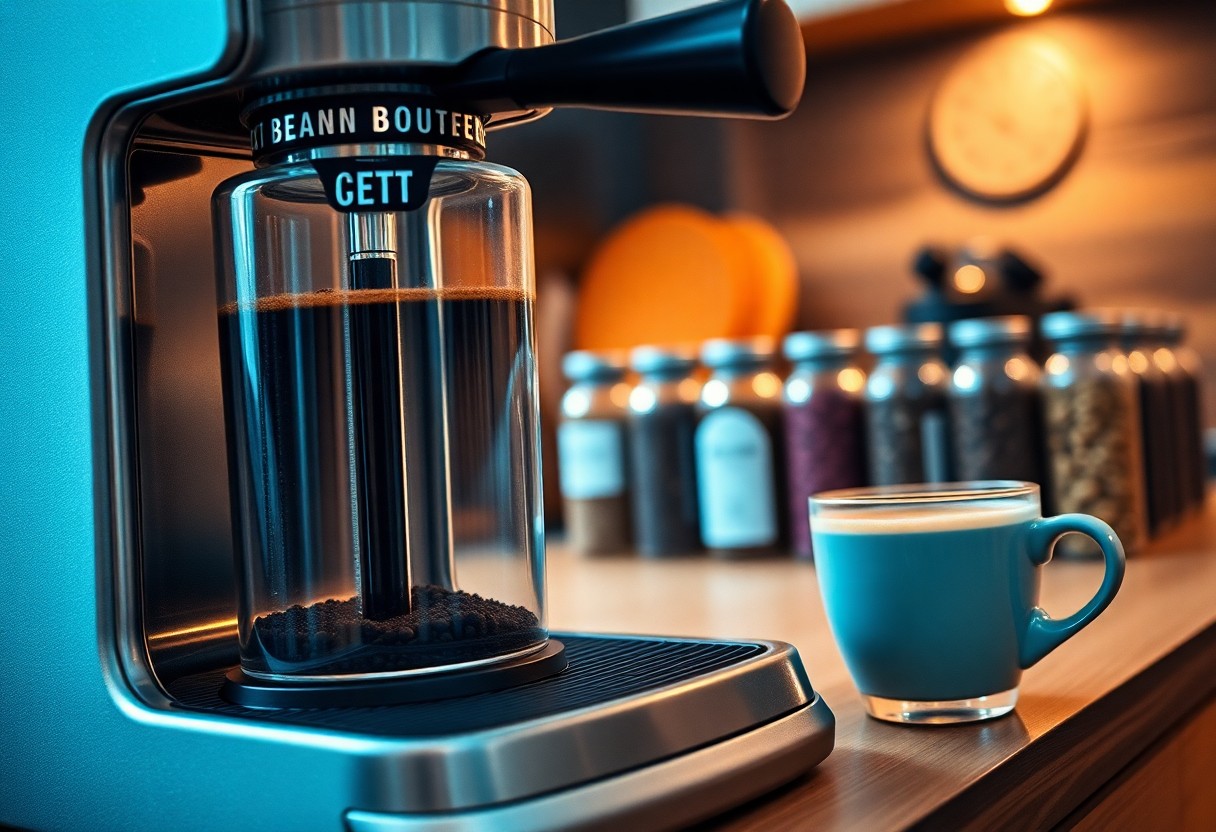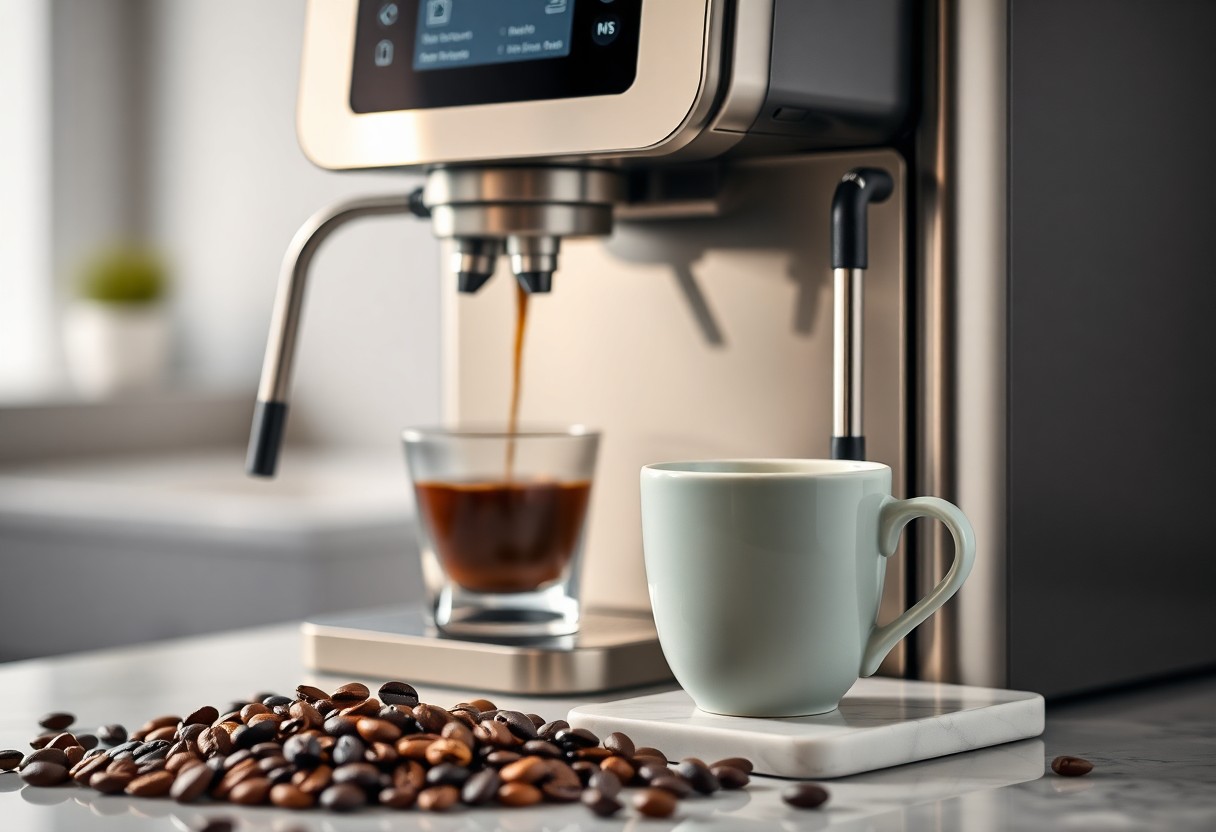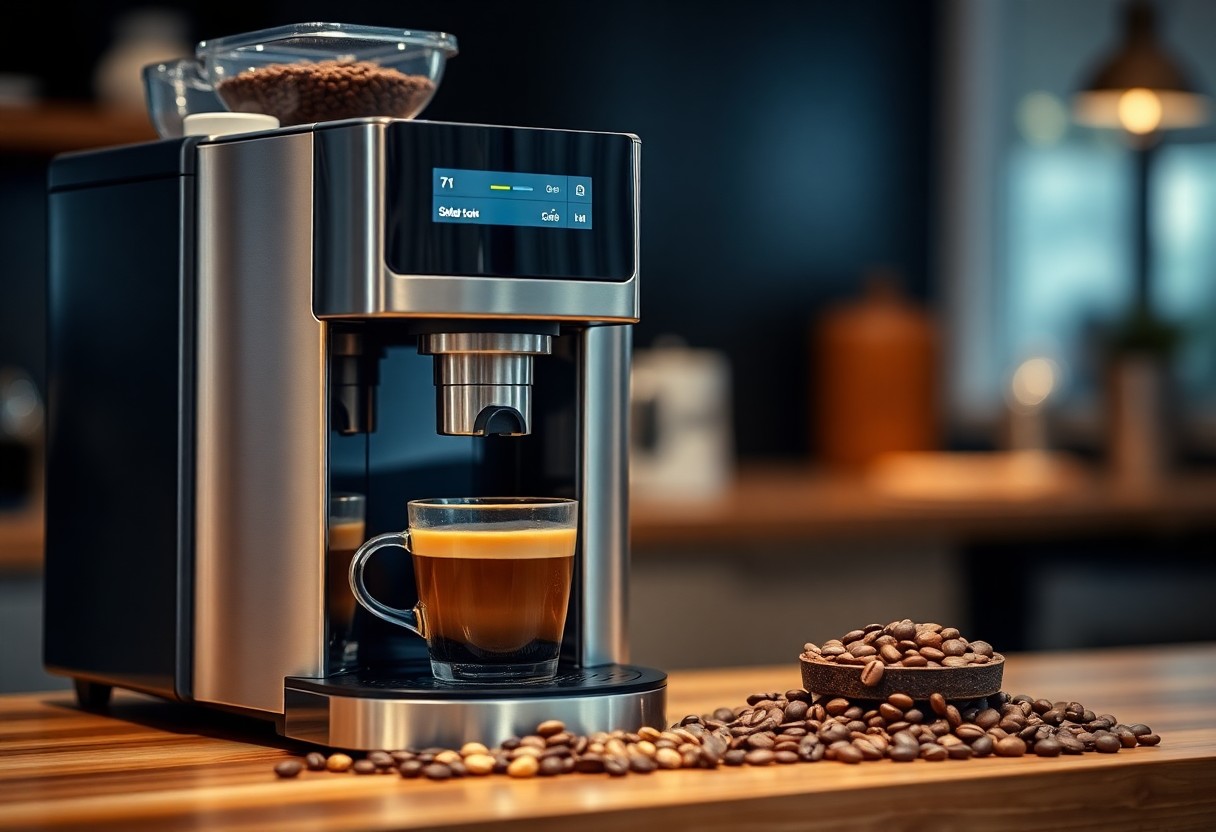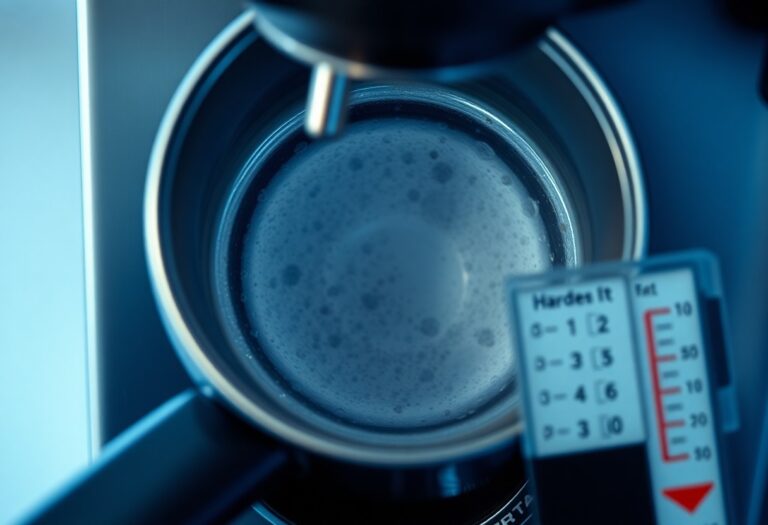Which Bean to Cup Coffee Machine – Fresh Grinding Selection
Over time, having the right bean to cup coffee machine can transform your daily caffeine ritual from mundane to extraordinary. In this guide, you’ll discover how to choose the best machine that meets your coffee preferences while ensuring fresh grinding for maximum flavor. You’ll learn about vital features, potential pitfalls, and the benefits of various models so that you can make an informed decision. Equip yourself with the knowledge to enhance your coffee experience and enjoy perfectly brewed cups whenever you desire.
Key Takeaways:
- Consider the grind settings available, as multiple options provide versatility for different coffee styles.
- Look for machines with built-in grinders that offer fresh grinding for optimal flavor extraction.
- Evaluate the machine’s capacity to hold coffee beans, ensuring it meets your brewing frequency.
- Check for ease of cleaning and maintenance features, which can save time and enhance longevity.
- Review customer feedback to gauge reliability and performance of specific bean to cup models.

The Core Elements of Bean to Cup Machines
Understanding the core elements of bean to cup machines allows you to make informed choices tailored to your coffee preferences. These machines encapsulate the entire brewing process, from grinding the beans to dispensing the final cup. Key features to look for include the grinding mechanism, brew strength control, and milk frothing capabilities, all of which contribute to the quality and consistency of your coffee experience. A well-designed bean to cup machine offers convenience without sacrificing the authenticity and flavor that fresh coffee brings.
Grind Size: The Key to Flavor Extraction
The grind size of your coffee beans directly influences the flavor and aroma of your brew. Finer grinds extract more flavor quickly, while coarser grinds allow for a slower extraction process. By adjusting the grind size according to your brewing method, you can significantly enhance the taste of your coffee. Experimenting with different settings helps achieve a perfect balance, bringing out the unique characteristics of each coffee bean.
Freshness vs. Convenience: Finding the Balance
Freshness is a vital aspect of coffee quality, but convenience plays an equally important role in your daily routine. Bean to cup machines provide the advantage of grinding beans instantly, ensuring maximum flavor and aroma. However, frequent grinding and brewing can be less convenient for those with a busy lifestyle. You need to assess your priorities—whether you’re inclined more towards savoring fresh coffee or prefer the efficiency of a quick setup.
For a harmonious blend of freshness and convenience, consider machines with adjustable settings that allow you to choose between on-demand grinding and pre-ground options. Some models even feature airtight bean hoppers that preserve freshness for longer periods while still allowing quick access for instant brewing. This flexibility enables you to adapt your coffee routine, empowering you to enjoy fresh coffee without the hassle whenever you wish. Prioritizing machines that offer both quality and convenience is key to making your morning ritual both enjoyable and efficient.
Choosing Your Ideal Bean Type
Selecting the right type of coffee bean can greatly enhance your brewing experience, influencing not just the flavor but also the overall aroma and body of your coffee. You may prefer the rich, smooth taste of Arabica beans, known for their sweet and complex flavors, or you might find the bold, bittersweet notes of Robusta beans to your liking. For insights into the best machines that can brew these beans to perfection, check out The 6 Best Coffee Makers with Grinders, Tested & Reviewed.
Arabica vs. Robusta: Flavor Profiles and Brewing Impact
The choice between Arabica and Robusta significantly impacts your coffee’s flavor profile. Arabica beans are celebrated for their delicate flavors, often presenting sweet, fruity, or floral notes, making them ideal for those who enjoy a complex taste. In contrast, Robusta beans deliver a stronger, more bitter flavor, with earthy or nutty undertones, constructing a body that’s typically thicker and more intense. Brewing with either type of bean can cater to different preferences; the brewing method may also highlight unique characteristics inherent to each bean type.
Single Origin vs. Blends: What Suits Your Taste?
Single-origin coffees are sourced from one location or farm, offering distinct flavors reflective of their individual terroir, while blends combine beans from various regions, creating a balanced and harmonious profile. Your ideal choice hinges on whether you’re seeking the unique qualities of a specific location or the consistency and complexity that blends can offer.
If you crave a unique tasting experience, single-origin coffees are an excellent choice, as they often showcase flavors reflecting their geographic origins. For instance, an Ethiopian Yirgacheffe may surprise you with its bright acidity and fruity notes, while a Colombian coffee may deliver a mellow, balanced cup. On the flip side, blends cater to those who prefer a consistent flavor profile that can be enjoyed daily. Many coffee enthusiasts appreciate the craftsmanship that goes into creating blends, as roasters often strive to highlight the best of various beans, yielding a well-rounded and delightful cup. Essentially, both single origins and blends have their unique appeal, and trying both will help you determine which satisfies your palate best.

Technology That Transforms: Grinding Mechanisms
Grinding mechanisms play a pivotal role in determining the quality and flavor profile of your coffee. Several designs exist, but the effectiveness of a machine often hinges on the technology it employs, leading to varying taste experiences. Machines utilizing advanced grinding mechanisms allow for precise control over grind size and texture, ensuring that you extract maximum flavor from your chosen beans, enhancing the overall brewing process.
Burr vs. Blade: The Grinding Debate
The debate between burr and blade grinders is longstanding among coffee aficionados. Burr grinders employ two revolving abrasive surfaces to crush the beans evenly, while blade grinders slice the beans with a rotating blade, resulting in a less uniform grind. Opting for a burr grinder typically yields superior results, as the even particle size ensures optimal extraction of flavors during brewing.
Grind Consistency: Why It Matters for Your Brew
Consistency in grind size significantly impacts the coffee’s flavor profile. A uniform grind allows for even extraction during brewing, ensuring that all flavor compounds are released simultaneously. In contrast, uneven grinds can lead to under-extraction of some particles and over-extraction of others, causing a disjointed taste, often resulting in bitterness or sourness. For example, a medium grind for drip coffee should ideally produce particles similar in size to granulated sugar for the best results.
Achieving grind consistency is necessary because different brewing methods require specific grind sizes to extract flavor optimally. For instance, espresso machines demand a fine grind, while a French press works best with a coarse grind. When you have a grinder that provides uniformity, you’re setting yourself up for a consistently delicious cup. In fact, testing shows that even minute differences in grind size can alter the taste profile significantly; thus, prioritizing a grinder with superior performance enhances your overall coffee enjoyment. Investing in a quality burr grinder can ensure that you’re brewing nothing short of excellence, transforming your morning ritual into a gourmet experience.
Brewing Techniques: Maximizing Bean Potential
Mastering your brewing technique can significantly enhance the flavor profile of your coffee. Adjusting parameters such as water temperature, brew time, and grind size allows you to unlock the unique notes of different beans. For optimal extraction, aim for a water temperature between 195°F and 205°F, and experiment with brew times—generally, a contact time of 4 to 6 minutes yields stellar results. By refining these techniques, you’ll discover the full potential of your chosen beans, resulting in a richer and more rewarding coffee experience.
Extraction Methods: Beyond Just Cup Quality
Exploring various extraction methods can drastically impact your coffee’s flavor and aroma. Techniques like pour-over, French press, and espresso each bring distinct characteristics to the forefront. For example, a French press allows for richer oils, creating a bold taste, while espresso delivers concentrated flavor and crema. Each method has its unique strengths, allowing for a wide range of enjoyment based on your coffee bean selection.
Customization Features: Personalizing Your Coffee Experience
Customization features on bean to cup machines let you tailor your coffee specifically to your taste. From adjusting grind settings to modulating brew strength and volume, these options allow for a uniquely personal brewing journey. You can also modify temperature settings to bring out specific flavors in your beans, ensuring that every cup is brewed just the way you like it.
Advanced machines even offer you the ability to store multiple user profiles, allowing each member of your household to save their preferred settings. Some devices provide smart technology, enabling you to schedule brews or adjust recipes via a mobile app. This level of control empowers you to experiment with various beans and brewing parameters effortlessly, ensuring that whichever blend you choose shines to its fullest potential each time you brew.
The Environmental Impact of Your Machine Choice
Considering the environmental footprint of your bean to cup coffee machine goes beyond just your daily brew. These machines often consume significant amounts of electricity during operation and manufacturing. Additionally, the materials used in their construction play a vital role in sustainability. Opting for machines made from recyclable materials and those designed for longevity can help reduce waste, benefiting the planet in the long run.
Sustainability Considerations: Beans & Machines
Your choice of beans also impacts sustainability. Selecting ethically sourced, organic coffee beans ensures that your caffeine fix supports sustainable agriculture practices. Pairing these responsible choices with eco-friendly machines, like those with minimal plastic parts, maximizes your positive contribution to the environment while enjoying your favorite brew.
Energy Efficiency: Long-term Savings and Benefits
Investing in energy-efficient bean to cup machines can lead to significant long-term savings on your electricity bills. Models with energy-saving modes automatically shut down after inactivity, minimizing unnecessary power consumption. Moreover, energy-efficient machines often maintain consistent brewing temperatures, enhancing coffee quality and reducing the need for frequent adjustments, ultimately benefiting both your wallet and the planet.
In fact, choosing an energy-efficient model can decrease your energy consumption by up to 30% compared to standard machines. Over time, this translates into substantial savings. For example, if your machine uses 1,000 kWh a year, opting for an energy-efficient model might reduce usage to around 700 kWh, saving you roughly $70 annually on your energy bill. Additionally, many environmentally friendly machines employ innovative heating technologies, such as thermoblocks, which offer quicker heating times, further conserving energy without compromising your caffeinated experience.
Conclusion
The selection of the right bean-to-cup coffee machine with fresh grinding capability can transform your coffee experience. By considering factors such as grind settings, brewing time, and ease of use, you can find a machine that aligns perfectly with your preferences and lifestyle. Whether you value convenience or the craft of brewing, your ideal machine awaits, ready to deliver fresh, aromatic coffee right in your home. Investing in a quality machine ensures that each cup you brew meets your high standards and satisfies your coffee cravings.
FAQ
Q: What is a Bean to Cup Coffee Machine?
A: A Bean to Cup Coffee Machine is an all-in-one appliance that grinds coffee beans and brews coffee automatically. It typically features an integrated grinder, water reservoir, and brewing system, allowing you to enjoy freshly ground and brewed coffee at the touch of a button.
Q: How do I choose the right bean for a Bean to Cup Coffee Machine?
A: When opting for beans, consider the roast type—light, medium, or dark—as well as the aroma and flavor profile. It’s best to experiment with different single-origin beans or blends to find your favorite taste. Additionally, ensure the beans are fresh, as freshness significantly affects the flavor of your coffee.
Q: Can I use pre-ground coffee with a Bean to Cup Coffee Machine?
A: Most Bean to Cup Coffee Machines are designed for whole beans; however, some models offer the option to use pre-ground coffee. If this feature is available, check the manufacturer’s instructions to ensure compatibility and to maintain optimal brewing results.
Q: How do I maintain my Bean to Cup Coffee Machine?
A: Regular maintenance involves cleaning the coffee brewing unit, hopper, and grinder frequently. Most machines come with specific cleaning cycles or removable components for easy cleaning. Additionally, it’s advisable to descale the machine periodically, depending on water hardness in your area, to prevent mineral buildup and ensure consistent performance.
Q: What features should I look for in a Bean to Cup Coffee Machine?
A: Key features to consider include adjustable grind settings, customizable brew strength, milk frothing capabilities, and programmable settings for convenience. A good machine should also have a clear display for ease of use, as well as a suitable size for your kitchen space and coffee consumption needs.







